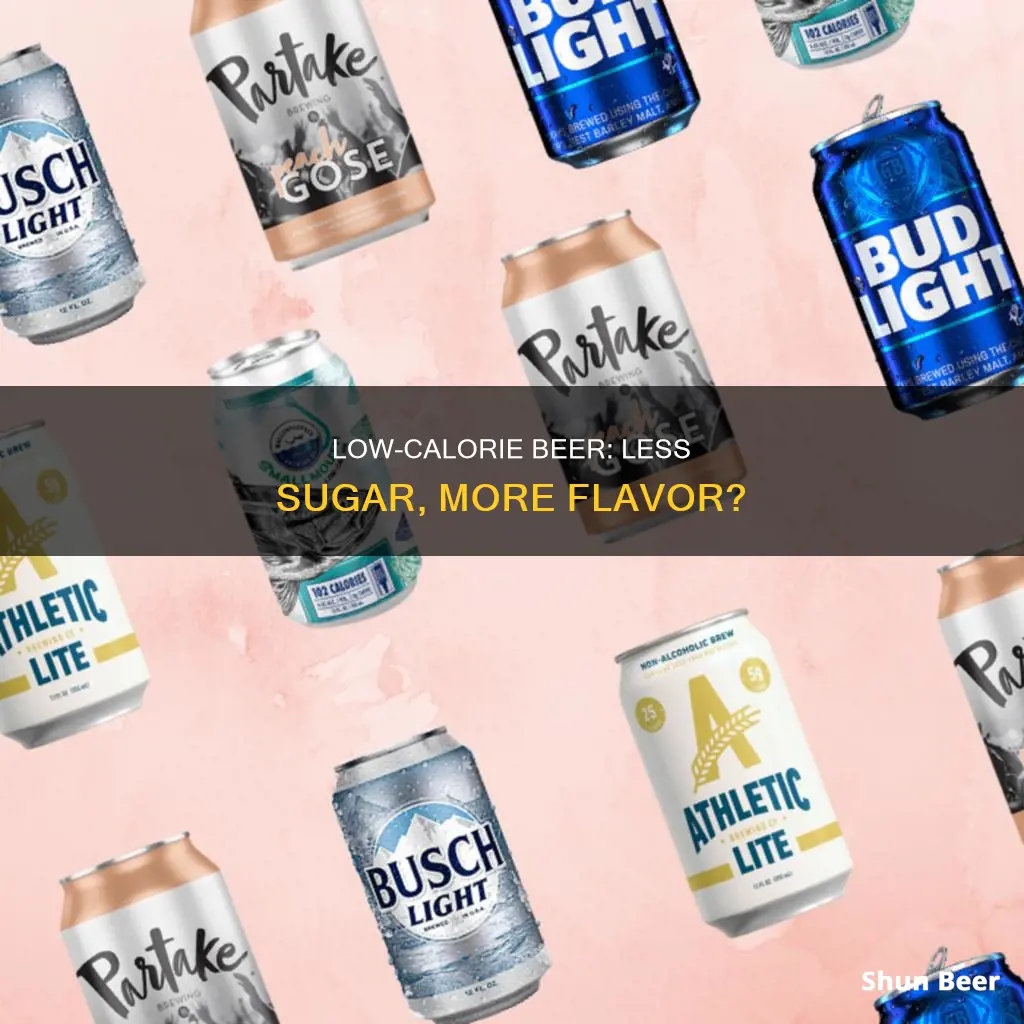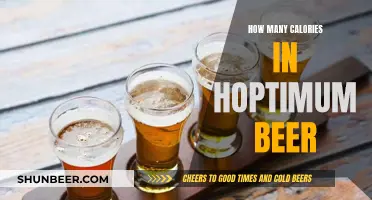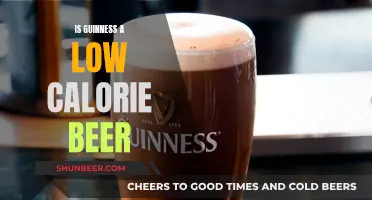
Beer is a popular alcoholic beverage, but it can be high in calories. The good news is that there are now many low-calorie beers available that don't compromise on taste. These beers are produced by lowering the number of carbohydrates from malt and grains and reducing alcohol content.
When it comes to sugar content, most beers contain very little added sugar. However, beer does contain carbohydrates, which can raise your blood sugar levels. Additionally, the sugar content in beer comes from the processing of grains and is then fermented by yeast to produce alcohol.
So, while low-calorie beers may have a slightly lower sugar content, the difference is not significant. The main benefit of choosing a low-calorie beer is reducing your overall calorie intake.
What You'll Learn

Low-calorie beers are not always low in sugar
Beer is generally made from grains, spices, yeast, and water. Barley and wheat are the most commonly used grains, and hops are the principal flavoring spice. While sugar is not added directly to the ingredients, it is necessary to produce alcohol. During the malting process, the controlled germination of the grain breaks down stored starch into fermentable sugar, mainly maltose.
The amount of sugar in beer depends on the initial gravity and the type of yeast strain used for fermentation. While most beers contain little sugar, light beers tend to have slightly more. For example, a 12-ounce serving of Miller Lite has 3.2 grams of carbohydrates and 0 grams of sugar, while Budweiser has 10.6 grams of carbohydrates and 0 grams of sugar.
Non-alcoholic beers, on the other hand, tend to have the highest sugar content. Since none of the sugar in non-alcoholic beers is converted into alcohol, they retain a higher sugar content. For instance, a 12-ounce serving of Coors Non-Alcoholic has 12.2 grams of carbohydrates and 8 grams of sugar.
When it comes to reducing calories in beer, brewers typically lower the number of carbohydrates derived from malt and grains, as well as reducing the alcohol content. However, it's important to note that low-calorie beers may still contain added sugars in flavored varieties.
While regular beers tend to be sugar-free, and light beers typically have less than 1 gram of sugar per can, the sugar content of low-calorie beers can vary. Therefore, it's always a good idea to check the nutritional information on the packaging or look up the information online.
In summary, while low-calorie beers may have fewer calories, they are not always low in sugar. The sugar content depends on various factors, including the type of beer, the ingredients used, and the fermentation process. To make an informed choice, it's important to review the nutritional information and practice moderation in consumption.
Pickle Beer Calories: Best Maid's Nutritional Breakdown
You may want to see also

Alcohol-free beers are often higher in carbs and sugar
Alcohol-free beers are often higher in carbohydrates and sugar than their alcoholic equivalents. This is because alcohol contains no carbohydrates, and the sugar in regular beer is fermented by yeast to produce alcohol.
Non-alcoholic beers, therefore, usually contain sugar, whereas regular beers tend to be sugar-free. However, the amount of sugar in non-alcoholic beers varies. For example, Heineken "0.0" contains 4.3g of sugar per 330ml, whereas Bitburger "Drive" contains only trace amounts. On average, there is around 1.5g of sugar per 100ml in non-alcoholic beer.
Non-alcoholic beers are also lower in calories than alcoholic beers, as alcohol contains roughly 7 calories per gram. However, they are not completely calorie-free, as the amount of calories varies depending on the amount of carbohydrates and protein the beer contains.
Sierra Nevada Torpedo Beer: Calorie Count and Nutrition Facts
You may want to see also

Beer is generally made without added sugar
Beer is generally made without adding sugar to the mix. The sugar in beer is created by the fermentation process, where yeast converts fermentable sugars into alcohol and carbon dioxide. The amount of sugar in beer is a result of how it is made.
The beer-making process starts with four basic ingredients: water, grains (often barley or wheat), hops, and yeast. The first step, malting, involves soaking, germinating, and drying the grains to convert stored starches into fermentable sugars. The malted grains are then soaked in hot water to release these sugars, creating a sweet liquid called wort. During boiling, hops are added for flavour and to balance the sweetness with bitterness, and the wort is sterilised.
Once the wort is cooled, yeast is introduced, and it ferments the sugars, producing alcohol and carbon dioxide. This critical step significantly influences the beer's final sugar content. While most sugars are converted, the residual sugar that remains contributes to the beer's taste and body.
The sugars involved in brewing come from the grains, not from direct addition (unless specified in particular styles like some craft beers that might use honey or corn syrup for a distinctive flavour). During fermentation, yeast converts these sugars primarily into alcohol and carbon dioxide.
The overall sugar content decreases because it is converted into alcohol and carbon dioxide. However, not all sugars are created equal. There are two main types of sugars in beer: fermentable and non-fermentable sugars.
Fermentable sugars, such as maltose, are converted into alcohol and carbon dioxide during fermentation. Non-fermentable oligosaccharides, on the other hand, are not digested by yeast and remain in the beer, adding body and a hint of sweetness. These non-fermentable sugars do not impact blood sugar levels as much, which may be a positive note for those watching their sugar intake.
Beer gravity, which refers to the density of the wort before and after fermentation, is a crucial factor in determining the sugar content of beer. High gravity beers start with a wort that is rich in sugars, resulting in a beer with higher alcohol content and often a sweeter taste. Low gravity beers, on the other hand, begin with less sugary wort, leading to a beer that is lower in alcohol content and residual sweetness.
In summary, while beer is generally made without adding sugar, the fermentation process and the type of ingredients used can result in varying levels of residual sugars in the final product.
Oktoberfest Beer Calories: How Many in One?
You may want to see also

Light beers are slightly higher in sugar than regular beers
However, it's important to note that regular beers are typically sugar-free, while light beers may have up to 1 gram of sugar per can. Nonetheless, non-alcoholic beers have the highest sugar content among these options.
Beer is generally made from grains, spices, yeast, and water. Barley and wheat are the most commonly used grains, while hops are the principal flavouring spice. The brewing process involves malting, mashing, boiling, fermentation, and maturation. During fermentation, yeast is added to the wort to convert sugars into alcohol and carbon dioxide.
While sugar is not directly added as an ingredient, it is essential for producing alcohol. The sugar content in beer primarily comes from the processing of grains, specifically the germination of the grains, which breaks down stored starch into fermentable sugar, mainly maltose.
The sugar content of beer can be determined by its beer gravity, which refers to the density of the wort relative to water at various stages of fermentation. A higher initial gravity indicates more sugar in the wort, resulting in a higher final alcohol content and lower residual sugar.
It's worth noting that the labelling regulations for alcoholic beverages in the United States do not require manufacturers to disclose the sugar content of their products, making it challenging to determine the exact sugar levels in different beers.
Calorie Count in Hoptimum Beer: Everything You Need to Know
You may want to see also

Non-alcoholic beers have the highest sugar content
This is because, during the fermentation process, sugar is converted into alcohol. So, in non-alcoholic beers, none of the sugar is converted, and it remains in the drink.
However, it's important to note that the sugar content of non-alcoholic beers varies depending on the brand and style. For example, Heineken 0.0 and Athletic Brewing Company's non-alcoholic beers have lower sugar content than other brands.
Additionally, while non-alcoholic beers have a higher sugar content, they are still a healthier option than alcoholic beers, as they have fewer calories and can help improve sleep, exercise, and alleviate anxiety.
Sugar is an empty calorie, offering little to no nutritional value. Excess sugar consumption can lead to weight gain and increase the risk of health issues such as heart disease, certain cancers, and type 2 diabetes.
The NHS recommends that adults consume no more than 30 grams of free sugars per day. Free sugars include added sugars in flavoured yogurts, fizzy drinks, and sweeteners, as well as sugars naturally present in fruit juices.
Non-alcoholic beer and diabetes
Non-alcoholic beer can be a good option for those looking to replace regular beer, as alcohol can negatively impact blood glucose levels. A study showed that non-alcoholic beer with modified carbohydrate isomaltulose reduced body mass index and improved blood glucose and insulin resistance in people with prediabetes or type 2 diabetes.
However, it is important to note that the high carbohydrate and added sugar content of non-alcoholic beers are generally not recommended for people with diabetes, according to diabetes.org.uk. It is always best to consult with a healthcare professional to determine the best options for your specific needs and health status.
Calorie Count in Miller High Life Beer
You may want to see also
Frequently asked questions
Yes, low-calorie beers generally have less sugar than their regular counterparts. However, it's important to note that not all low-calorie beers are created equal, and some may have more sugar than others. Additionally, alcoholic beverages are not required to disclose their sugar content on nutrition labels in some countries, making it challenging to determine the exact sugar content.
Brewers reduce the number of carbohydrates derived from malt and grains to lower the calorie content. They also reduce the alcohol content, as alcohol itself contains calories.
Lagers, stouts, and ales can all be found in low-calorie varieties. There are also non-alcoholic and gluten-free options available that tend to be lower in calories.
Some popular low-calorie beers include:
- Budweiser Select
- Molson Ultra
- Coors Light
- Miller Lite
- Heineken Light
- Corona Light
- Guinness Extra
- Dogfish Head Slightly Mighty
- Lagunitas DayTime







